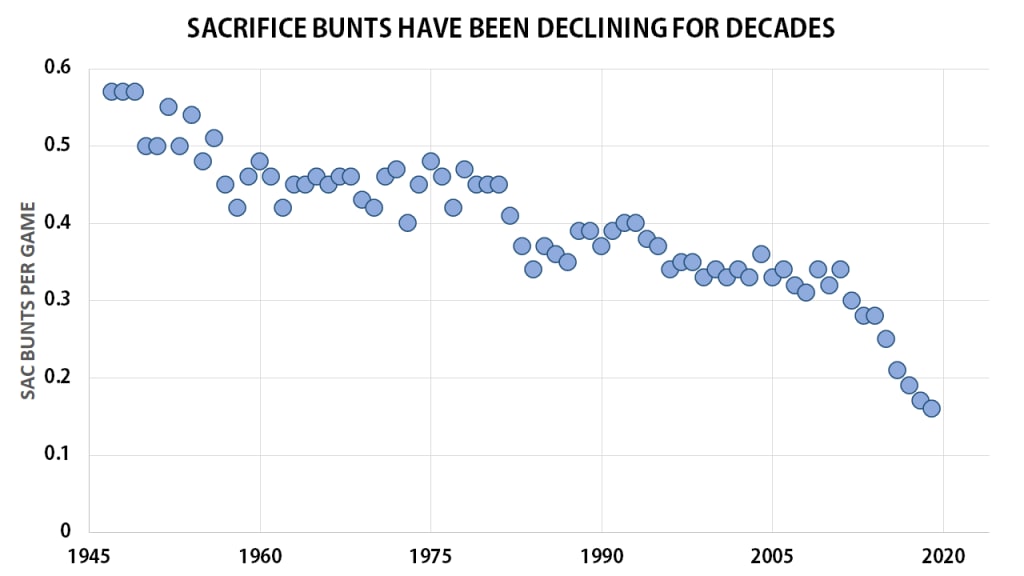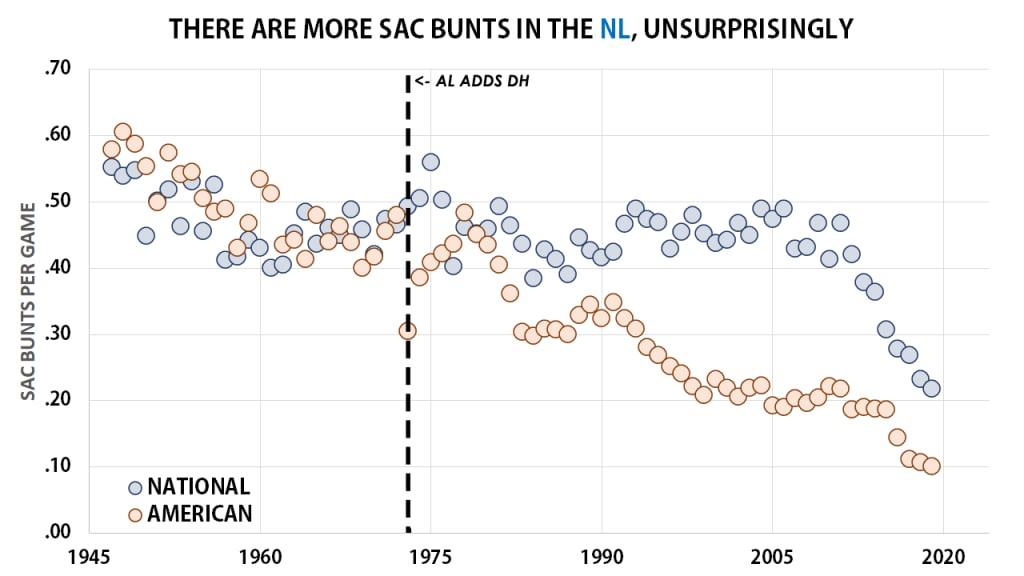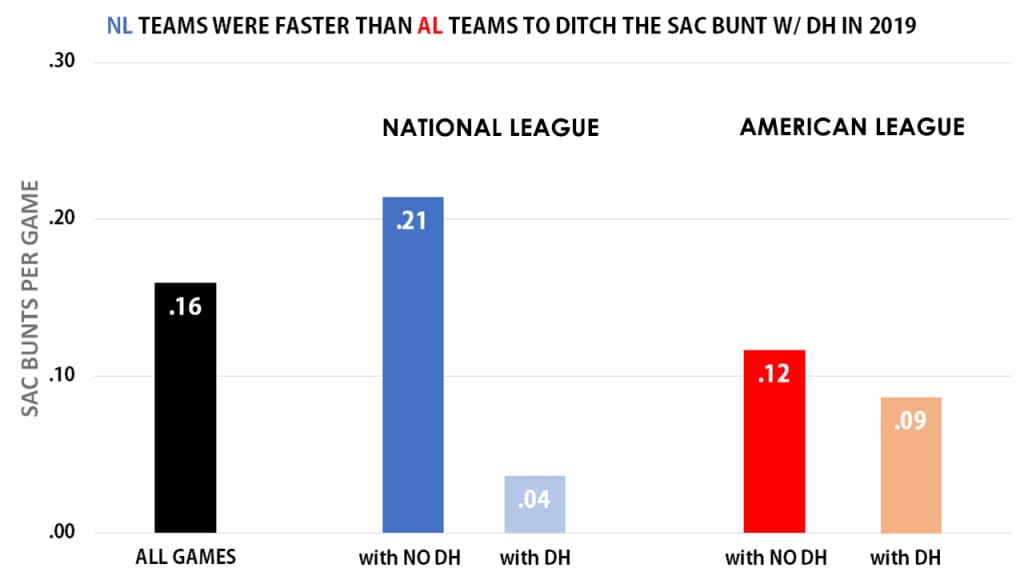
When the 2020 Major League Baseball season gets started, you already know it's going to look like nothing you've ever seen, and you already know why. Forced to adapt due to the effects of the worldwide COVID-19 pandemic, this version of a baseball season will feature 60 games, a totally reworked schedule and likely no fans in the stands. It's going to be ... different.
Nowhere, perhaps, will that be more noticeable than in the National League, which will have the designated hitter full-time for the first time. (Not that the DH in the NL is an entirely new thing, after all; last year, NL designated hitters saw 3,050 pitches on the road during Interleague Play, plus 441 more in the World Series.) While most discussions of this will focus on things like "this is perfect for Nick Castellanos and the Reds" or "maybe the Mets can find room for Pete Alonso and Dominic Smith now," we're most interested in a more big-picture question, one of unintended but not entirely unwelcome consequences:
What if this is the thing that finally ends the sacrifice bunt entirely?
We hardly need to explain that the sac bunt is rare enough as it is, but just to set up the point let's recap where sac bunt prevalence stands. In 2019, there were .16 sac bunts per team game, the lowest number on record, breaking the previous low set in '18, which broke the previous low set in '17, which broke the ... you get the point. In 1998, the first year of the 30-team era, there were 1,705 sac bunts. Last season, there were just 776. Sac bunts are out. Dingers are in.

So, there are very few sac bunts as it is. And, unsurprisingly, most of them come from pitchers -- of last year's 776 sac bunts, 431 of them (55.6%) came from pitchers. (The Dodgers, for example, had 52 of their 55 sac bunts come from listed pitchers, but it's really 53 of 55, or 96%, because one of the other three was pitcher Kenta Maeda pinch-hitting for a pitcher.)
That's a number that's been increasing over time, really. While position players have largely abandoned the practice, pitchers haven't, so their share of total sac bunts has gone up. We just said nearly 56% of sac bunts were from pitchers in 2019, right? That was 50% in 2009, 40% in 1999, 27% in 1989 and 22% in 1979. When we stop allowing pitchers to hit, a huge number of sac bunts will disappear with them.
You could leave it there, saying there would have been 345 remaining sac bunts in 2019 if pitchers didn't hit. (Yes, DHs would take more plate appearances, but they don't bunt; there was just one DH sac bunt in '19, and that was a huge fluke, considering that Gorkys Hernandez's seventh-inning bunt on Sept. 17 came as the third Boston DH of the day, since starter J.D. Martinez and replacement Sam Travis had each left with injuries.)
But that's not entirely right, because AL pitchers hit in NL parks -- they won't in 2020 -- and NL pitchers already didn't hit in AL parks, so instead, to look forward, let's look back. We're fortunate enough to have had one league already turn to the DH back when the American League did it in 1973, and because of Interleague Play, we can also look to see how NL teams have behaved when they've had the DH available against when they haven't.
What did the AL do after the DH began?
This isn't a perfect comparison, of course, because as the above chart showed, the sacrifice bunt didn't really start heading toward extinction until about 10 years ago, almost certainly the result of sabermetrics infiltrating front offices and advancing the idea that the base you gain -- or might gain, since a bunt attempt is hardly a guaranteed success -- is usually not worth the out you surrender, except for very specific situations.
Still, it's worth looking at. We can see that between 1947, when Jackie Robinson integrated baseball, and 1972, the final year that pitchers hit in the AL, that the leagues dropped sac bunts at roughly the same rate. It took a few years for AL managers to get the hang of it, with the leagues dropping sac bunts at an equal rate as late as 1979. But the next year, the AL had fewer sac bunts than the NL, and it's been that way ever since, with a record gap of 729 more bunts in the NL in 2006, though it's been shrinking as sac bunts have become less popular generally.

It might not happen immediately, but if the leagues were this similar before the AL had the DH, it's reasonable to expect they'd look similar again once the NL has it, too.
In 2019, there were half as many sac bunts in the AL (245, or .10 per game) as there were in the NL (531, or .22 per game). Now, some of those AL bunts came from pitchers in NL parks, but not that many -- only 24, or about 10% -- while an overwhelming number of last year's NL sac bunts (407, or nearly 77%) came from pitchers. So you can expect a small decrease in AL sac bunts ... and a massive decline in NL ones.
How differently did 2019 teams act without the DH?
Here is something extremely obvious: In 2019, teams sacrifice bunted less often in games with the DH (.08 per game, or 221 sac bunts) than they did in games without the DH (.20 per game, or 555 sac bunts). Obviously.
But what was fascinating was when we narrowed it down to just National League teams. When they were freed from the pitcher hitting, it seems like they got so excited to have the DH, that they all but removed the sac bunt from their vocabulary entirely.

See that drop? AL teams went from .12 sac bunts per team game with the DH to .09 without it, an expected but relatively minor drop. That is, they weren't dropping many sacrifice bunts when their pitchers had to hit, and they put down slightly fewer when they didn't have to hit.
But in the NL, the drop was much, much larger. With the pitchers hitting, they put down .21 sac bunts per game -- that's 555 total -- and when they got to use the DH, they put down a mere .04 sac bunts per game ... or only 11. Eight of the 15 NL teams didn't put down a sac bunt in an AL park at all last year.
Which makes the upshot ...
So: Is this all good or bad? That's largely an aesthetic question, one that won't have the same answer for everyone. You might like the sweet strategy of a well-placed sac bunt. You might prefer a hitter who can actually hit. If we know anything about the pro-DH/anti-DH argument, it's that you'll never satisfy everyone. This has been going on for nearly 50 years now. It might go on again in 2021, since it's possible (though probably unlikely) this is a one-year switch and pitchers could hit again.
But as Lucas Apostoleris wrote at Baseball Prospectus in April, not only are pitchers awful hitters (just .128/.159/.163 with a 44% strikeout rate in 2019), there's increasing evidence they're awful bunters, too, noting that "it’s basically a coin flip as to whether or not a bunt attempt will even be hit into fair territory," and pointing out that "despite the fact that pitchers add such little value when they swing the bat, it’s STILL on average a more detrimental outcome for them to bunt!"
So sure, there are some well-placed sacrifice bunts, like this one. There are also a ton of horror shows, like this:
There's one more thing to consider here, which could potentially increase sacrifice bunts:
In extra innings, there will be a runner placed on second base to start each inning.
This is almost certainly going to be the most controversial rule change for 2020, even more than the DH being in the NL, because at least you've seen the DH in the AL for decades. You've never seen this, at least not at the Major League level, and one worthy argument against it is that it will lead to sacrifice-bunt-ball; that is, unless a star hitter is leading off, managers will immediately call for the sacrifice bunt to change "runner on second with no one out" to "runner on third with one out."
Will it? One way to check into that is to see how the odds of scoring a single run -- which is all you'll usually care about in extra innings -- changes in those situations. Let's take a look at the data from 2019 to check out the differences:
No outs, runner on second: At least one run scored 60.7% of the time
One out, runner on third: At least one run scored 64.9% of the time
So that might be an argument for more bunts, though perhaps not as many as you'd think. Only about 8% of games even went to extras in 2019, don't forget, and again, calling for a sacrifice bunt is not the same thing as successfully executing one. That is, a manager signaling for one is not the same as turning their run expectancy from 60.7% to 64.9%. That would be true only if it's always successful, which it's of course not. (Plus, again: If your leadoff hitter is Mike Trout or Christian Yelich or Pete Alonso, you're letting him swing away.)
The sacrifice bunt won't go away entirely, not this year and likely not ever. There are still rare situations where it makes sense -- mainly if your hitter coming to the plate is very weak, and you're interested in scoring a single run more than you are several runs, and you have a specific runner/out situation like "man on second with no out" -- and every team has a non-pitcher position player or two who exists for speed or defense, not power. And let's be clear that "a sacrifice bunt" is not the same thing as "bunting for a hit." There will still be bunts.
But there will be fewer, so many fewer. We'll never all agree on if that's a good thing. But it will definitely be a thing.
